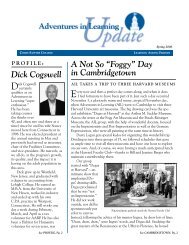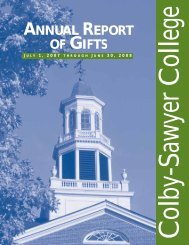Fall 2012 Issue - Colby-Sawyer College
Fall 2012 Issue - Colby-Sawyer College
Fall 2012 Issue - Colby-Sawyer College
You also want an ePaper? Increase the reach of your titles
YUMPU automatically turns print PDFs into web optimized ePapers that Google loves.
Photos: Michael Seamans<br />
On a warm and bright<br />
morning last October, 12<br />
<strong>Colby</strong>-<strong>Sawyer</strong> students<br />
and two professors prepared<br />
to set off for a<br />
four-day journey into the<br />
high peaks of the Presidential<br />
Range in the White<br />
Mountains National<br />
Forest. Dressed in layers,<br />
they strapped on backpacks<br />
stuffed with sleeping<br />
bags, warm jackets, food<br />
and other supplies and hit<br />
the Tuckerman’s Ravine<br />
Trail for an ascent into the<br />
alpine zone.<br />
The students—mostly<br />
junior and senior biology,<br />
environmental studies<br />
and environmental science<br />
majors—were part of<br />
Associate Professor of<br />
Natural Sciences Laura<br />
Alexander’s Alpine Flora<br />
Communities course.<br />
In the previous month they<br />
had learned about the<br />
fragile ecosystems that<br />
inhabit high-altitude alpine<br />
regions, where plants are<br />
buffeted by high winds,<br />
heavy snow and extreme<br />
cold. Field guides close<br />
at hand, the students were<br />
anxious to find and identify<br />
these plant communities<br />
in the wild and experience<br />
the environment to which<br />
these species have<br />
adapted.<br />
The course includes<br />
a few day hikes and this<br />
longer expedition marked<br />
the addition of a new<br />
Alpine Communities Field<br />
Studies Program. It is the<br />
fourth field study program<br />
to be added to the<br />
curriculum, after Desert<br />
Communities (in Arizona),<br />
Marine Communities (on<br />
Martha’s Vineyard) and<br />
River Communities (in the<br />
Colorado River Basin).<br />
The hike began at about<br />
a 2,000-foot elevation and<br />
quickly turned rocky and<br />
steep. Professor Alexander<br />
kept the group focused<br />
by making frequent stops<br />
to point out plant communities<br />
along the trail and<br />
reminded students to keep<br />
an eye on how species<br />
appeared and disappeared<br />
with changes in elevation.<br />
She prodded them with<br />
questions: When did the<br />
hardwood forest transition<br />
to a spruce fir forest?<br />
Which plant communities<br />
should we be seeing<br />
now? What are the major<br />
impacts on the flora in<br />
this area?<br />
The next day, the group<br />
climbed up Tuckerman’s<br />
Ravine on the way to<br />
Lakes in the Clouds and<br />
Mt. Monroe. The trail<br />
grew narrower and more<br />
arduous, but the views<br />
were stunning. When the<br />
group took a break, Harvey<br />
Pine, assistant professor<br />
of Natural Sciences,<br />
explained the geological<br />
origins of the amphitheater<br />
that surrounded them.<br />
Like an impassioned<br />
preacher, he raised his<br />
arms and voice as he<br />
described how hundreds<br />
<strong>Fall</strong> <strong>2012</strong><br />
59









